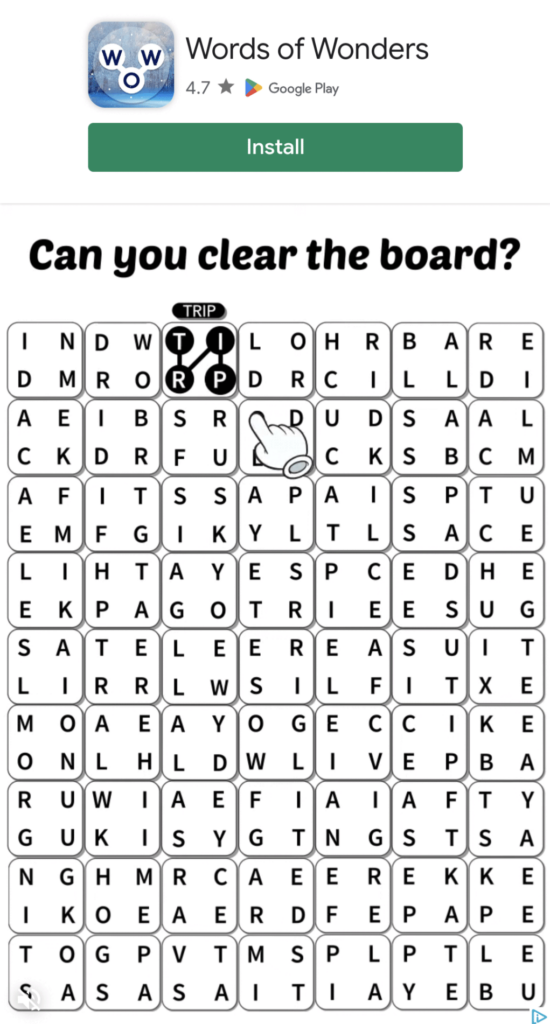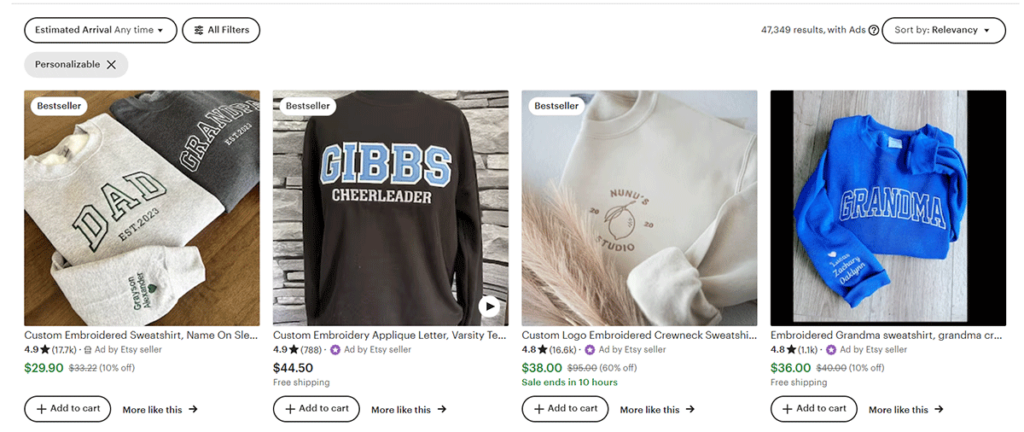15 online advertising examples to reach more customers
As the world grows more dependent on online platforms and mobile devices, advertising on the internet is becoming a critical strategy for businesses of every size. By 2027, global online advertising revenue is expected to exceed $1 trillion—a testament to the power of digital channels and the countless ways to reach potential customers online.

So what does internet advertising entail and why does it matter? Here, you’ll discover different types of ads you can use to promote your brand along with effective online advertising examples to inspire your next marketing campaign.
What is online advertising?
Online advertising is a marketing strategy involving paid promotions of a brand, product, or service on internet-based platforms, such as websites or mobile apps. It allows your business to share its marketing message with a specific target audience on a prominent, digital ad space.
Why is online advertising important?
Online advertising is a cost-effective marketing method that can rapidly improve your return on investment (ROI). It enables businesses to select who they want to reach based on key characteristics—such as demographics (like age and gender), location, and interests—so they can cater their marketing message accordingly. This can heighten the effectiveness of every ad campaign. In fact, personalized interactions often drive a 10-15% revenue lift.
This contrasts the capabilities of traditional advertising methods like TV ads and billboards. These channels are designed to reach mass audiences, making ads pricier and far less relevant.
Digital advertising can also help businesses reach global audiences fast. Over 64% of the world uses the internet—including 92% of people from countries with high income—which means electronic advertising can spark widespread brand awareness or enable highly targeted, local success.
Businesses can also benefit from the reporting capabilities of internet ads. Web-based advertising platforms track real-time data about your ad performance, including click-through rates (the percentage of people who click on your ad link) and conversion rates (the percentage of people who take a desired action, like buying a product or signing up after viewing your ad). As a result, you can quickly determine the best ad formats and content for your brand to get better ROI from your ad spend.
Online advertising examples
The term “online advertising” can describe many digital marketing strategies. To show you its vast potential, here are 15 different types of online advertising you can use, along with effective internet ad examples.
1. Banner ads

Also known as display ads, banner ads have been around since the early days of the internet. One of the simplest types of internet advertising, display ads allow businesses to “rent” a designated ad space on a website—usually a horizontal display at the top of a web page.
Display advertising is simple to use. Once you have a graphic prepared with the right dimensions—you can use free templates from a design tool like Canva to make a professional one within minutes—all you need to do is select your target market and set your budget. Some ad platforms also allow you to use videos or animations in your banner ad.
Effective banner ads, like the online advertisement example above from Sweet James, should include a clear call to action (CTA) that drives clicks to the homepage of your website or a standalone landing page. Using your brand colors and other brand elements can also help you catch the attention of internet users.
2. Pay-per-click ads
Pay-per-click (PPC) ads maximize your ROI by ensuring your ad spend goes toward more meaningful interactions. PPC ads often don’t require any upfront cost—you’ll only pay each time your ad receives a click. This increases the likelihood that your dollars are helping you reach people who are interested in what you have to offer.
PPC ads can take many shapes and forms. They can be found across a wide variety of platforms—from social media and search engines to Yelp and YouTube—as they have quickly become a preferred online advertising method.
The exact cost you’re paying for every click can vary—usually from a handful of cents to a few dollars—depending on the platform you’re using, the keywords and audience you’re targeting, and similar factors. However, PPC ads give you significant control over your budget and target market, which you can adjust in real time.
Get more leads
Reach more customers with placements on search and competitors' pages.

3. Native ads
The majority of consumers regularly see native ads, and 64% at least somewhat trust what they say. This shows the effectiveness of native ads, which are designed to look like any other content on the platform—for example, an article on a news website—except for a subtle “Promoted,” “Sponsored,” or “Paid Post” designation.
When you invest in native ads on major publishing platforms, it’s common practice for staff members to create native ad content on your behalf to ensure it aligns with the standards of their platform. For instance, this sponsored article looks and feels like a typical feature story on Insider, highlighting quotes and stories from a local food tech startup. However, it’s actually sponsored by the Singapore Economic Development Board and serves to highlight the organization’s support of innovative companies.
Publishers can lend their content expertise while you can collaborate with them to send your desired brand message.
However, if you want to save money and create your own native ads, platforms like LinkedIn and Facebook allow you to simply boost or promote your existing posts. These ads will appear just like any other post, but they’ll appear on the feeds of your target audience members instead of just your followers.
4. Product placements
We’ve all seen product placements in our favorite TV shows and movies. The following ad within “Stranger Things,” which promoted KFC as part of a scene, is a strong example of how product placement ads appear within our favorite content.
This type of advertising—also known as embedded marketing—is making its way into more internet-based content. Subtle promotions can be found within YouTube content, Twitch streams, mobile game environments, and social media pictures.
In the online adverts example below, an influencer seamlessly weaves in subtle imagery of a health product into a recipe-focused Instagram Reel. It’s only by scrolling to the bottom of the lengthy caption that you’d find out they’re an official partner of the brand.

These examples of online advertisements show how product placements, like native ads, can help you promote products to savvy shoppers through the art of subtlety.
5. Interstitial ads
The opposite of a subtle product placement is the full-screen interstitial ad. These online ads, which often pop up in mobile games, take over the entire app interface—usually as users move between pages, levels, and other natural pauses.
Effective interstitial ads are highly engaging and interactive. For instance, the mobile advertising example below invites users to play a sample of the promoted game right on the ad. When the entertainment value of the ad is high, it can feel less intrusive (perhaps even enjoyable) and prompt more users to click and follow through with your desired action.

These types of online advertising can also be valuable because they often require users to stay on the screen for a certain amount of time. This boosts the likelihood that they’ll remember your brand, especially if they see your ads more than once.
6. Video ads
As the number of global video content viewers continues to rise every year, the power of video advertising is growing. These types of ads engage internet users through a combination of visuals, audio, text, and movement—and they capitalize on the TikTok-driven popularity of short-form video content today.
Video ads can take a few formats, all of which can be beneficial to businesses. On social media platforms, they can be standalone video ads displayed on user feeds with a caption. On video sharing and streaming platforms, video ads can also be displayed right before or during relevant video content.
YouTube videos can also be promoted to prominent ad spaces—even if they’re not searchable on their own. For instance, the online advertising example below from McCormick remains unlisted on its own YouTube page, despite showing up on select users’ home screens and recommended video lists over the duration of the video ad campaign.
7. Audio ads
Have you ever listened to a podcast or streamed music without a subscription? If so, odds are you’ve listened to audio ads. With many internet users flocking to Spotify, Apple Music, Pandora, and similar platforms to listen to audio content on their smartphones, many brands are moving away from radio ads and toward online audio ads.
This type of online advertising is played before and during audio content—usually between songs and at natural transitions during a podcast. Audio advertising probably isn’t the most effective way to drive sales since users may not look at their mobile phones as they listen. But a memorable jingle or slogan can elevate your small business branding efforts by making your business more recognizable and memorable.
Other sound effects, like the cracking and sizzling of a soda can, can also entice users to consider new products—particularly as ASMR content, which stimulates users through sound, grows in popularity.
8. Shopping ads
E-commerce brands can use shopping ads—which typically display a product image, title, and price—to drive users straight to a specific product page and win sales. These types of ads often appear on search engines like Google and Bing and marketplaces like Amazon and Etsy when shoppers enter a relevant keyword. For instance, when searching for “custom embroidered sweatshirts” on Etsy, you can find a row of shopping ads above the search results.

These promoted product listings are great shopping ads because they display good product photos with clear product names—and they even use sale pricing to further entice any user who scrolls by.
Shopping ads are also available on platforms like Facebook and Instagram. But on these social media apps, shopping ads may appear like a typical post—although an on-app product page is clearly clickable and tagged.
9. Yelp Ads
When you want to reach high-intent purchasers, Yelp is an excellent place to run an online ad. Users visit the platform to seek out products, services, and brands in a local area—and businesses that run Yelp Ads get 2.5x more leads than those who don’t.
Yelp Ads are cost-effective PPC ads that display your business page in a number of key places on the site and mobile app, such as above or below relevant search results in the “Sponsored Results” sections and on your competitors’ pages. Your ad can include a CTA button, like “Request an Appointment” as shown in the online advertising example below, that allows you to capture sales leads and details about the specific products or services your leads are seeking.

Plus, Yelp Ads can highlight your best picture, review, Verified License badge, and more to help you build trust before users click into your Yelp Page.
You can fully customize your ad design, target locations and keywords, and budget—or you can let Yelp optimize your ad campaign for you.
Before investing in online advertising on Yelp, be sure to claim or add your Yelp Business Page, add high-quality pictures, and fully fill out your business information, including your website, phone number, and office hours. Doing so can set your business apart and help potential customers make informed purchase decisions.
Get more leads
Reach more customers with placements on search and competitors' pages.

10. Search ads
Search ads, which allow your website to appear above or beside relevant search results, can instantly boost your brand’s visibility. This can drive website traffic faster than organic (unpaid) search engine optimization (SEO) efforts—and it can be cost-effective since search ads follow the PPC model.
If you’re targeting keywords with local intent—for example, “dentists near Phoenix, AZ”—search ads can even help your company appear in highly visible search engine results page (SERP) features. In the image below, you can find these search ad examples in order:
- Two local services ads, which encourage users to call or message a business
- One standard search ad linking directly to the practice’s website
- One sponsored business in the “local pack,” which highlights a few local businesses on a prominent map

With these online advertising examples, you can see how each type of ad can draw a potential customer’s attention in different ways.
11. Social media ads
For many small businesses, social media marketing has become a simple way to connect with prospects and clients, but it can be easy for posts to get lost in the constant stream of content within any social network. Social media advertising—which can include LinkedIn, TikTok, Instagram, X, and Facebook ads—shines the spotlight on your content and helps you reach users who aren’t already following your brand.
Most social media platforms offer a handful of ad formats—from image and video ads to lead ads that let users submit their phone number or email without leaving the app. The following Facebook advertising campaign shows a classic image ad from EveryPlate that uses bright brand colors, a well-lit photo, and a big sales promo to catch the eyes of social media users.

This online ad also provides a great example of concise copy. The simple language speaks to the audience’s fear of missing out—making it clear that the deal won’t be around for long—and drives action through CTAs.
12. Retargeting ads
Retargeting ads, also known as remarketing ads, are designed to reach audiences that have already engaged with your company. This type of online advertising uses cookies, which track activity on your site, to identify who has visited your website or specific web pages. This allows you to promote your brand, product, or services to people who are already interested and may just need a little extra push to make a purchase.
While these retargeting ads may sound high-tech, they’re actually easy for anyone to install. Many online marketing platforms offer a snippet of code that you can simply add to the backend of your site and instructions are typically brief and straightforward. This code snippet may be known by various names—for instance, the Pinterest tag, Google Conversion ID, LinkedIn Insight Tag, and Meta Pixel on Facebook and Instagram. However, you can usually find it by looking for remarketing ad options on your platform of choice.
13. Influencer ads
Did you know 69% of consumers trust influencers, friends, and family members more than they trust brands? When today’s savvy shoppers see your ads, they know they’re being marketed to. However, they already have a certain level of trust in the influencers they follow so if your marketing message comes from those content creators, they’re less likely to question its truth.
While you might think of influencers as Instagram or TikTok users with millions of followers, local influencers with as little as 1,000 followers can be just as powerful (and often have more affordable rates). The best influencers for you to work with are those who:
- Align with your values
- Post about related topics (like interior design for a paint brand)
- Have a target audience similar to your own
- Have a significant amount of engaged followers who like, comment on, and share posts
The influencer ad below shows an example of how content creators can send your brand message in their own tone of voice.

14. Affiliate marketing
While influencer ads are shared by influential content creators—often for the sake of brand awareness or lead generation—affiliate ads can be shared by any third party and tend to be heavily focused on driving sales. Affiliate marketing involves paying publishers or social media users commission for every sale that comes from their “affiliate link,” which puts the onus on them to promote and sell your products or services over time.
The biggest perk of this type of ad is the fact that you only need to pay if you get a sale. If you don’t get sales, your brand will still be shared with new networks, which can lend a hand to brand awareness.
15. Interactive ads
Interactive ads include any online advertisements that encourage users to actively engage with and participate in your campaign. This can take a variety of forms—from clickable polls and playable ads (like in the interstitial ad example) to augmented reality (AR) experiences and Snapchat filters that include your brand name. Interactive ads can even provide instructions—for example, how to professionally fold a bedsheet if you run a hotel or cleaning service—to get users to stop and engage.
These types of ads are designed to keep user attention on your brand for longer periods of time. The activity you provide helps them remember the experience, which in turn helps them keep your brand in mind.
Elevate your online advertising strategy now
Using different types of online ads in your marketing strategy can help you reach more members of your target audience while getting the data you need to improve your campaigns. These 15 online advertising examples can provide inspiration—whether you want to invest in a subtle native ad or product placement, get your business in front of more users on Yelp, or remarket to the same people more than once.